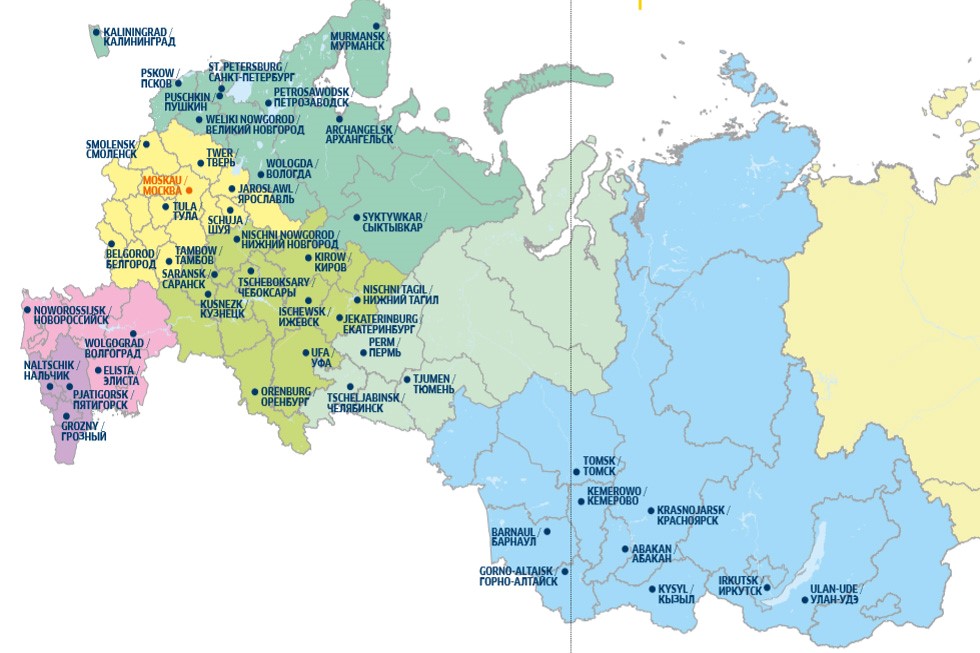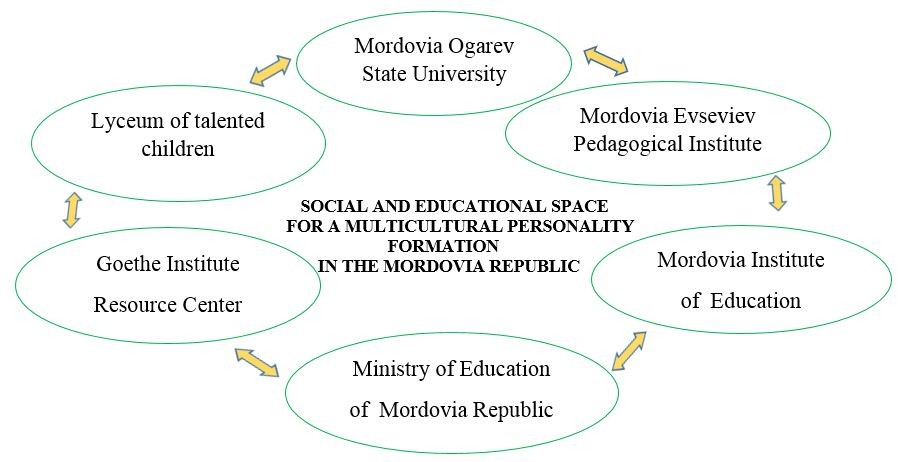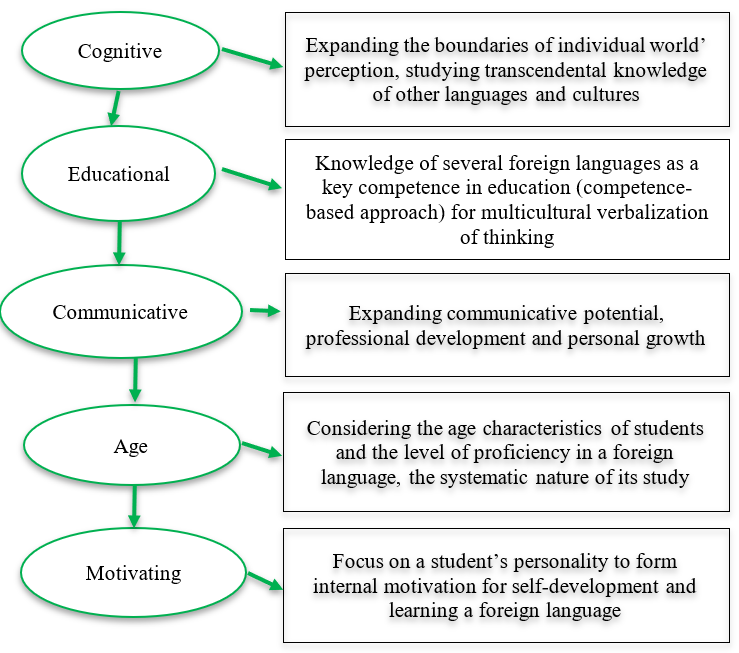Многоязычие в глобальном мире: преимущества, проблемы и перспективы развития
Многоязычие в глобальном мире: преимущества, проблемы и перспективы развития
Аннотация
Многоязычие – это социокультурный феномен, проводник информационной грамотности и важный компонент всестороннего развития личности, который сегодня является одним из главных условий стратегии успеха каждого человека. В статье представлены преимущества изучения нескольких иностранных языков в современном обществе. Методология исследования основана на теоретических исследованиях и эмпирическом опыте совместных проектов Союза преподавателей немецкого языка (Республика Мордовия, Россия) и Гёте-института (Москва, Россия). Был проведен дискурсивный и интерпретационный анализ многоязычия с учетом различных факторов, таких как когнитивные способности, межкультурная коммуникация, образование, личностный рост, психофизиология, мотивация. В результате мы выяснили, что развитие многоязычия является перспективой успешных межкультурных отношений в глобальном мире. Был продемонстрирован российский опыт преподавания немецкого языка как второго иностранного. На основе проекта Гёте-Института "Немецкий как второй иностранный язык" были установлены причины неохотного введения второго иностранного. Были намечены направления укрепления многоязычия в российском образовании на основе его положительных аспектов. Анализ исследования и последующие выводы важны для всех сфер жизни человека (образование, общение, психология, самоидентификация, мотивация к саморазвитию, лингвистика и регионоведение). Результаты исследования будут полезны современным потребителям, независимо от их социального статуса и этнической принадлежности.
1. Introduction
Multilingualism indicates that people’s thoughts “do not stick to the words of the same language”
. Indeed, multilingualism as an essential component of communication in a multicultural world is an indicator of a person’s spiritual freedom, a direct consequence of the cultural, political, and economic diversity of social reality. Multilingualism as a phenomenon of socio-cultural reality in the modern world is an indicator and a prerequisite for everyday life, which (in addition to the above) contributes to the peaceful resolution of conflict situations during cultural interaction. The close connection between language and culture is embodied in the information “code,” implying such value orientations as cultural traditions, the mentality of the people, and stereotypes; it is transmitted to future generations as a communicative message. Therefore, the cultural context is extremely important during communication between representatives of different ethnic groups, namely, ethnic identity, knowledge of ethical and religious rules, motivation to establish intercultural ties and self-realization in various socio-cultural aspects.The Russian writer Leo Tolstoy spoke fluently English, German, French; he could read Italian, Czech, and Polish, spoke a little Church Slavonic, Greek, Ukrainian, and Latin. The writer also wanted to learn Dutch, Turkish, Bulgarian, and Hebrew. Undoubtedly, knowledge of many languages opens access to huge information resources of the world’s significance and other peoples’ historical and cultural heritage.
The prospects of a multicultural personality in the modern world of new technologies are studied by both domestic and foreign philologists. Bilingualism and multilingualism were the subjects of many scientific researchers, such as S. Canagarajah & S. Dovchin
, I. Gogolin & G. Lüdi , I. Fuchs, St. Jeuk, & W. Knapp , M. Byram , M. Porto, S.A. Houghton & M. Byram , N. Safonova , E. Montanari & Ju. Panagiotopoulou , M. A. Lourenço & Is. Ana , and others.Studying foreign languages is especially important. Many countries have encouraged learning English to achieve specific purposes in certain fields. Accordingly, their learners need language courses to perform their specific needs. For that reason, there is a focus on a learner-centered approach, which has great effects on the emergence of certain language programs to be taught to achieve all learners’ needs.
Thus, the new trends in this field of language teaching led the educational system to train teachers to be qualified to teach the courses upon the learners’ central needs. The new trend towards learning English also has changed the concept of grammar-translation method for a set of rules to language communication method as explained by G. Kniffka, & Th. Roelcke
, Cl. Benholz, M. Frank, & E. Gürsoy . The scholars assumed that English for specific purposes [ESP] is a multi-dimension approach that requires a variety of roles to perform. To perform these roles, the ESP practitioner should have a significant awareness of psychological needs and profound knowledge, as well as be open-minded, curious, and enthusiastic with ESP. That is why the authors prefer to define ESP as an approach rather than a product. Therefore, ESP does not follow a specific type of language, teaching materials, or methodology. For this reason, language learning should be aimed not only at academic practice but also at tasks related to work and social communication.2. Research methods and principles
The effectiveness of studying two or several foreign languages was shown using discursive and interpretive analysis based on statistical data on the Republic of Mordovia and 45 pilot regions of Russia. Such a way of education leads to a deeper study of a foreign language and one’s own culture. In this paper, we used a comparative analysis of the updated information by the beginning of 2021 regarding the introduction of a second foreign language on the territory of Russia and in our own region.
The study aims to (1) identify the reasons for the reluctance of some Russian comprehensive schools to introduce a second foreign language and (2) make proposals to strengthen the position of multilingualism in the Russian education system based on the identified positive aspects of multilingualism.
The research hypothesis is as follows: multilingualism (or plurilingualism) is the use of several languages (most often, two languages) within a certain social community. Thus, together with the language, culture, speech etiquette, worldview, history, and traditions of the speakers of this language are studied, which leads to a productive result: along with universal human values, a person is engaged in their own education and enriched with many “keys to one lock” (Voltaire’s term), adequately perceiving specific realities of other cultures; at the same time, the diversity of cultural worlds is preserved.
We define the concept “multilingual personality” in the following way: multilingual personality is considered as a person who, along with linguistic competence, owns intercultural and socio-cultural ones and can fully use the knowledge of a foreign language and culture in the dialogue.
3. Main results
Thanks to the Federal State Standard of Russian Education (Order of the Ministry of Education and Science of the Russian Federation No. 1577 dated December 31, 2015)
, the relevance of multilingualism in 2015 in Russia has increased, according to the amendments.It should be clarified that the Russian secondary education system up to this point implied studying one of the foreign languages (English, German, French, Spanish, or Chinese). However, now there is a tendency towards a widespread reduction in the number of students who desire to learn less common languages (German, French, Spanish).
This opportunity was used by researchers of Goethe German Cultural Center in Moscow (www.goethe.de/moskau) to give the start to the project “German is the first Second Foreign Language,” aimed at popularizing German among students and their parents, as well as school administrations and teachers and improve the teaching of German in Russian schools through innovative teaching techniques.

Figure 1 - Regions participating in the project in 2021: 45 regions of the Russian Federation
Note: source [5]

Figure 2 - Social and Educational space for a multicultural personality formation in the Mordovia Republic
Note: compiled by the authors
The Resource Center operates on the territory of the republic, acts as a coordinating link between the Goethe Institute and educational institutions of Mordovia (especially with comprehensive schools). Thanks to this, during four and half years (2016–2021), the second foreign language (German) was introduced in 76 schools of the republic. Since 2022 the name of the project changed to "Kompetenz Deutsch". Statistics for Russia and Mordovia are graphically presented in Table 1.
Table 1 - General statistics of the number of educational institutions in the Russian Federation that supported the project “German is the first second foreign language” during 2016-2020
Statistics | Number of educational institutions (schools) in the Russian Federation that supported the project “German is the first second foreign language” during 2016–2020 | ||||
2016–2017 | 2017–2018 | 2018–2019 | 2019–2020 | Total for 2021 | |
Russian Federation | 146 | 567 | 779 | 792 | 2,312 |
Republic of Mordovia | 20 | 5 | 22 | 29 | 76 |
Note: compiled by the authors
4. Discussion
Thus, the prospects for learning several foreign languages are great. The key advantages of multilingualism include several aspects (Fig. 3), which we described in detail in one of our papers and which some international and Russian researchers paid attention to , , .

Figure 3 - Positive multilingual studying aspects
Note: compiled by the authors
Despite the advantage of multilingualism, there is a paradoxical situation in Russia when many schools have not yet introduced “The Second Foreign Language” into their curricula. As experts of the Mordovia Republic Resource Center, we know the reasons for such a situation:
· School administrations. The main reason for the negative attitude towards the second foreign language is the lack of qualified teachers of the German language. The starter package for schools in pilot regions is perceived as insufficient (once immediately after introducing the second foreign language). So second foreign language is not perceived as a “necessary” subject;
· German language teachers. The main reason is the lack of support from the school administration;
· Public. The main reason is the compulsory study of two native languages (for example, Chechen + Russian), as well as national (Mordovian, Bashkir, Chuvash, and many others), which manifested itself in the reluctance of the public (including parents) to give “surplus” knowledge to their children. There are also some concomitant factors; for example, in the east of Russia, the Chinese language is more popular.
Thus, we concluded that to strengthen the position of multilingualism, it is necessary to motivate young specialists to work at schools, improve the qualifications of already working foreign language teachers, and expand network interaction.
5. Conclusion
The “Multilingualism” concept can be characterized not only by personal and social features; it can also concern political and institutional phenomena. All these aspects are rarely at the same level. Contrary to popular ideas, these representatives of multilingual institutions are often not multilingual. Multilingualism is often assessed very differently, and few people have balanced skills in the different languages of their repertoire. Further research will focus on “individual multilingualism,” more than the addition of several languages.
Based on theoretical analysis and practical experience, we showed that the productivity of multilingualism is due to several factors:
(1) transcendental one, by which we mean “immersion” deep into the knowledge of other cultures;
(2) educational factor, which forms multilingualism, one of the key competencies of the competency-based approach in education;
(3) communicative factor, which opens up many ways for person’s professional formation and increases social competence to become a “connoisseur” of a foreign and native culture;
(4) motivating the factor due to which teaching foreign languages in one language group is much more effective if one already has knowledge of the first foreign language, which helps quickly master the second and subsequent foreign languages.
Designing a multilingual educational space in a multiethnic region creates great prospects for the development of multilingualism in the global world. It can be solved by several ways:
1) by the prolongation of a project related to the introduction of a second / third foreign language into the curricula of educational institutions;
2) by the development and organization of project activities with the involvement of a foreign language, contributing to the practice of successful intercultural interaction.
Thus, despite the controversies of learning a second foreign language, we understand that due to multilingualism, the existence of humanity will noticeably expand, the transmission mechanism of information literacy will strengthen. Also, the picture of the world will be considered under the heterogeneous perspectives; thinking will be more flexible, and people will become more tolerant, increase competitiveness, and independently design a strategy for their own success, carefully preserving the identity of each nation.
